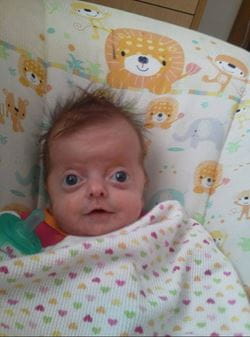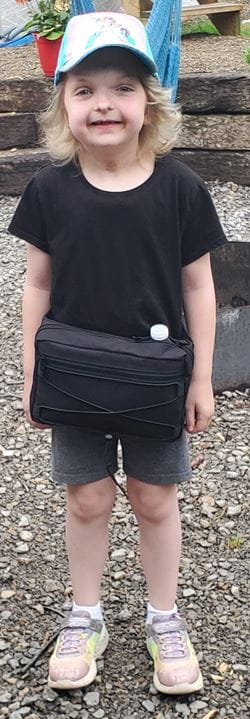When Madelynn Reddinger was born in rural northwestern Pennsylvania in May 2014, her doctor thought her facial features indicated she might have Down syndrome. Her parents, Danielle and Larry, were doubtful. Their biggest concern was her breathing.
Although they were able to take their newborn home, they were terrified. “It was scary. We were fighting to get her to eat through her breathing,” says Danielle.
“Her breathing was terrible,” adds Larry. “We have two other children. We knew this wasn’t normal. That’s why we pushed to go to UPMC Children’s Hospital of Pittsburgh.”
A worrisome diagnosis

Madelynn was a month old when she was referred to UPMC Children’s Hospital for genetic testing. But when they arrived, the concerned geneticist quickly sent her to the Cleft-Craniofacial Center for an immediate evaluation by center director Jesse Goldstein, MD, a craniofacial plastic surgeon, and his team of specialists.
After watching Madelynn eat, the center’s clinical coordinator and speech pathologist Matt Ford, MS, CCC-SLP, recommended a swallow study. The test confirmed she was aspirating liquid into her lungs and the infant was admitted and a feeding tube inserted.
The Reddingers soon learned their daughter had Crouzon syndrome, a rare genetic disorder that resulted in multisuture craniosynostosis. It is a condition where some of the bones of the skull prematurely fuse together. Over the next two weeks, additional tests revealed other related conditions: Chiari malformation (a structural defect that caused her brain tissue to extend into the spinal canal) and midface hypoplasia (undeveloped upper jaw, cheekbones, and eye sockets).
Madelynn would need multiple surgeries in the years ahead to shape her skull and properly align her face and jaw. The timing depended on her natural growth and development. Led by Dr. Goldstein, her Cleft-Craniofacial Center team would include specialists in craniofacial surgery, neurosurgery, and ear, nose, and throat (ENT) surgery.
“Dr. Goldstein told us not to Google the syndrome, saying we’d see the worst of the worst and she wasn’t that bad. But we did anyway — and scared ourselves to death,” says Larry.
Early surgeries
Madelynn initially went home to Franklin, Pa. “Our biggest fear was making the right decisions at the right time to ensure her brain had room for growth,” says Danielle.
“We put a lot of trust in Dr. Goldstein and the other doctors,” says Larry. “If they recommended something, we knew it needed to happen. They are very good at what they do.”
At five months, Madelynn had an emergency shunt procedure at UPMC Children’s to treat hydrocephalus. At 12 months, she had her first major surgery — a posterior cranial vault distraction — to open the back of her skull to make room for her growing brain. While she recovered at home, her parents turned a screw each day to adjust the distractors and slowly widen the gap.
At age four, Madelynn’s ENT doctor removed her adenoids and tonsils to open up her airways. A tracheostomy tube also was inserted to help her breathe.
“Once we saw how peacefully she slept with the breathing tube after surgery, we knew the trach was the right thing to do,” says Danielle.
A transformational procedure
Two years later, Madelynn, age 6, had another major surgery — a transformational procedure known as monobloc surgery. Dr. Goldstein and pediatric neurosurgeon Ian Pollack, MD, worked together to move her forehead, eye sockets, cheek bones, and upper jaw into better positions.
After recovering in the hospital for 10 days, Madelynn left with a halo device attached to her skull that connected to her jaw and forehead with wires. At home over the next couple of weeks, the Reddingers twisted the screws on the halo daily to slowly move her face forward. She wore the halo for another three months while her bones healed.
When Madelynn’s bandages were removed after the surgery, her parents were shocked. “It was amazing. Her incisions looked wonderful — we couldn’t even see them,” says Danielle.
They also were amazed at her transformation into a “totally different child.”
“She has a new smile. That took some getting used to,” says Danielle. “But she looks amazing now and I’m so happy for her.”
“Her demeanor changed since the last surgery,” says Larry. “She looks better and feels better. She’s living a comfortable life now.”
Looking forward
 Madelynn continues to make progress in other ways. Her feeding tube was removed in 2020 and she hopes to have her tracheostomy removed soon. She will likely need another surgery to pull her lower jaw forward, plus additional minor cosmetic surgeries.
Madelynn continues to make progress in other ways. Her feeding tube was removed in 2020 and she hopes to have her tracheostomy removed soon. She will likely need another surgery to pull her lower jaw forward, plus additional minor cosmetic surgeries.
The second grader is described by her parents as an active, “feisty ball of fire” with a great attitude. “She constantly amazes us. She’s so positive despite all her medical stuff. Her attitude is: let’s get it done, so we can move on,” says Danielle.
Although she must be careful because of her trach and the Chiari malformation, Madelynn enjoys being outside running around. She also loves arts and crafts and horses. She’s very involved in her trach care and always willingly explains to other children how it helps her breathe.
Grateful parents
Danielle and Larry say they’re grateful for the support they received from the entire Cleft-Craniofacial Center team over the years. During Madelynn’s first year, they made 80 trips to Pittsburgh from Franklin — a 126-mile roundtrip drive from their Franklin home. And though they never accepted it, the staff repeatedly offered them gas money to ease the financial burden.
“They are all so supportive,” says Larry. “And everyone works together as a team. The communication is terrific, and that goes a long way toward building trust.”
But they are most grateful for Dr. Goldstein and the team for their commitment to ensuring Madelynn and other children receive the best care needed “to live a normal life: to eat, breathe, feel, and look normal.”
“Thanks is not enough,” says Larry.
“Dr. Goldstein changed our lives. He changed our daughter’s life,” says Danielle. “You really can’t put that into words.”
Plastic Surgery Resources
Read more about plastic surgery resources from UPMC Children's Hospital Department of Plastic Surgery.









